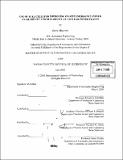| dc.contributor.advisor | Ernest G. Cravalho, Michael J. Driscoll and Michael W. Golay. | en_US |
| dc.contributor.author | Akkaynak, Derya | en_US |
| dc.contributor.other | Massachusetts Institute of Technology. Dept. of Aeronautics and Astronautics. | en_US |
| dc.date.accessioned | 2006-03-29T18:45:05Z | |
| dc.date.available | 2006-03-29T18:45:05Z | |
| dc.date.copyright | 2005 | en_US |
| dc.date.issued | 2005 | en_US |
| dc.identifier.uri | http://hdl.handle.net/1721.1/32444 | |
| dc.description | Thesis (S.M.)--Massachusetts Institute of Technology, Dept. of Aeronautics and Astronautics, 2005. | en_US |
| dc.description | Includes bibliographical references (leaves 119-121). | en_US |
| dc.description.abstract | To assure safe shutdown of a nuclear power plant, there must always be reliable means of decay heat removal provided, in last resort, by an Emergency Core Cooling System (ECCS). Currently the majority of nuclear power plants in the US utilize diesel generator sets as on-site emergency power generating units. In addition to the loss of off-site power, plants can lose their on-site AC power, a condition known as Station Blackout, which increases the calculated probability of reactor core damage significantly. This study evaluates how suitable fuel cell systems are today for improving back-up power performance on nuclear power plant sites and how suitable they can be projected to be by year 2030, when Generation IV reactors are planned to be deployed. The main system under consideration was the Gas Cooled Fast Reactor, due to its gas coolant and high power density, and therefore the need for an ultra-reliable shutdown cooling system. Fuel cells were identified as a preferred candidate because of their efficient continuous operability, and because most nuclear plants already have existing on-site hydrogen supply and storage systems. This study uses the operational data of 15 phosphoric acid fuel cells installed on U.S. Department of Defense bases starting in the year 1994 as the basis for assessment of currently proven technology. Analysis of data shows that the largest contributor to forced outages is the electrical subsystems and that the fuel cell stack operates with high reliability and availability throughout its lifetime. | en_US |
| dc.description.abstract | (cont.) Results underline important technical issues affecting the use of fuel cell systems on nuclear plant sites today and suggest that given the time frame for the deployment of Gen-IV reactors, improvements in the performance of electrical and support systems together with advances in hydrogen generation and storage, the potential of highly reliable fuel cell systems will be realized. | en_US |
| dc.description.statementofresponsibility | by Derya Akkaynak. | en_US |
| dc.format.extent | 128 leaves | en_US |
| dc.format.extent | 5385888 bytes | |
| dc.format.extent | 5392160 bytes | |
| dc.format.mimetype | application/pdf | |
| dc.format.mimetype | application/pdf | |
| dc.language.iso | eng | en_US |
| dc.publisher | Massachusetts Institute of Technology | en_US |
| dc.rights | M.I.T. theses are protected by copyright. They may be viewed from this source for any purpose, but reproduction or distribution in any format is prohibited without written permission. See provided URL for inquiries about permission. | en_US |
| dc.rights.uri | http://dspace.mit.edu/handle/1721.1/7582 | |
| dc.subject | Aeronautics and Astronautics. | en_US |
| dc.title | Use of fuel cells for improving on-site emergency power availability and reliability ad nuclear power plants | en_US |
| dc.type | Thesis | en_US |
| dc.description.degree | S.M. | en_US |
| dc.contributor.department | Massachusetts Institute of Technology. Department of Aeronautics and Astronautics | |
| dc.identifier.oclc | 61719553 | en_US |
